-
Countries
-
Data and Analysis
-
Special Focus
-
Crisis Responses

Contact
DTM Sudan; dtmsudan@iom.int
Language
English
Location
Sudan
Period Covered
Mar 21 2024
Mar 28 2024
Activity
- Mobility Tracking
- Baseline Assessment
Overview
On 15 April 2023, armed clashes erupted between the Sudanese Armed Forces (SAF) and the Rapid Support Forces (RSF) in multiple cities across Sudan. Clashes initially took place in cities across Northern and Khartoum states, later spreading across the Darfur and Kordofan regions.
Highlights
- DTM Sudan estimates that 6,622,565 individuals (1,320,273 households) were recently internally displaced.
- The IDP caseload was observed in 7,076 locations across all of Sudan’s 18 states.
- The highest proportions of IDPs were observed across South Darfur (11%), River Nile (11%), and East Darfur (10%).
- Field teams reported that the IDPs observed were originally displaced from twelve states. The majority (3,570,032 IDPs, 54%) were reportedly displaced from Khartoum state; followed by South Darfur (15%), Aj Jazirah (9%), North Darfur (9%), Central Darfur (4%), West Darfur (4%), South Kordofan (2%), East Darfur (1%), West Kordofan (1%), North Kordofan (1%), Sennar (1%) and White Nile (<1%).
- IOM-DTM also reported that an estimated 2,031,858 mixed cross-border movements were made into neighbouring countries.
- This product provides brief insights into those displaced in Sudan post-15 April 2023. For more granular information on the IDP caseload and the displacement context, please see IOM-DTM's Monthly Displacement Overview 07.

Contact
DTM Mozambique, DTMMozambique@iom.int
Language
English
Location
Mozambique
Period Covered
Nov 26 2023
Dec 02 2023
Activity
- Other
- Survey
Artisanal mineral extraction attracts high numbers of migrants within Mozambique, and the southern African region more widely. These informal mining points are particularly vulnerable to communicable diseases, and communities often have limited access to basic social infrastructure, including health facilities.
The Artisanal Miners' Demographic and Migration Profile Assessment (AMDM) aimed to explore the socio-economic and migratory patterns of artisanal miners in two significant locations: Gile, Zambezia, and Cahora Bassa, Tete. In focusing on these two remote mining areas in Zambezia and Tete respectively, the AMDM provides an evidence base that complements IOM's support to a migrant-friendly health service model that bridges gaps between migrants and host communities in vulnerable regions.

Contact
IraqDTM@iom.int
Language
English
Location
Iraq
Period Covered
Sep 01 2023
Sep 14 2023
Activity
- Mobility Tracking
- Event Tracking
Due to an increasing number of evictions announced for families in informal settlements, the International Organization for Migration’s (IOM) Displacement Tracking Matrix (DTM) in Iraq launched an emergency tracking tool in September 2023 to understand the number of affected people and their main characteristics.

Contact
IraqDTM@iom.int
Language
English
Location
Iraq
Period Covered
May 01 2023
Aug 01 2023
Activity
- Survey
- Displacement Solutions
With the end of the conflict with the Islamic State of Iraq and the Levant (ISIL), protracted displacement has come to characterize the post-conflict environment in Iraq. Around 1.14 million people remain internally displaced, nearly all of whom fled their areas of origin more than five years ago. In light of the above, it is essential to advance durable solutions to displacement in Iraq by improving living conditions to enable internally displaced persons (IDPs) to voluntarily take steps towards return, local integration or settlement in new locations. The Displacement Index (DI) is a tool designed to measure and monitor the living conditions of IDPs. Data collection for DI Round 7 took place between May and August 2023 across 18 governorates, 103 districts and 2,614 locations of Iraq. During this round, 24 fewer locations of displacement were assessed, compared to the previous round collected in January – April 2023, when 2,638 locations were assessed, as IDPs either returned to their areas of origin or moved to another location of displacement.
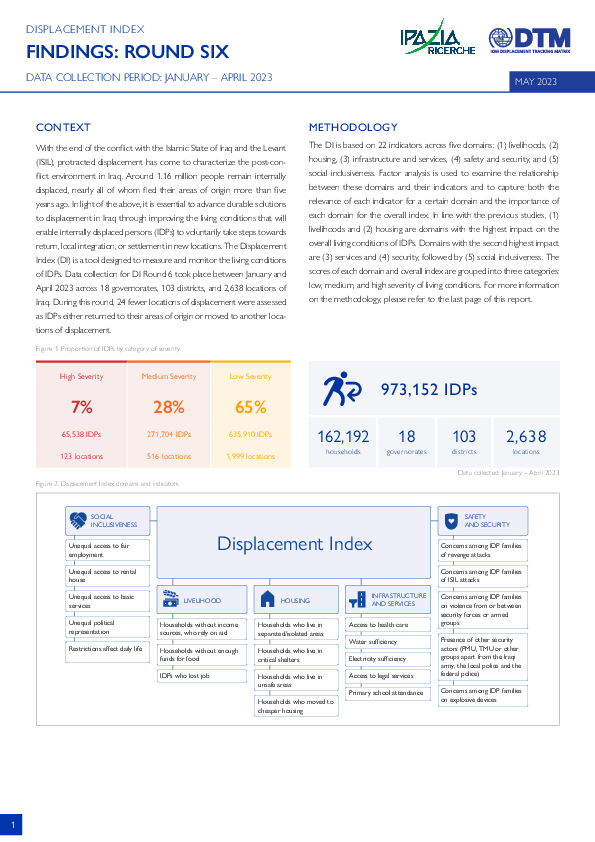
Contact
IraqDTM@iom.int
Language
English
Location
Iraq
Period Covered
Jan 01 2023
Apr 01 2023
Activity
- Survey
- Displacement Solutions
With the end of the conflict with the Islamic State of Iraq and the Levant (ISIL), protracted displacement has come to characterize the post-conflict environment in Iraq. Around 1.16 million people remain internally displaced, nearly all of whom fled their areas of origin more than five years ago. In light of the above, it is essential to advance durable solutions to displacement in Iraq through improving the living conditions that will enable internally displaced persons (IDPs) to voluntarily take steps towards return, local integration, or settlement in new locations. The Displacement Index (DI) is a tool designed to measure and monitor the living conditions of IDPs. Data collection for DI Round 6 took place between January and April 2023 across 18 governorates, 103 districts, and 2,638 locations of Iraq. During this round, 24 fewer locations of displacement were assessed as IDPs either returned to their areas of origin or moved to another locations of displacement.
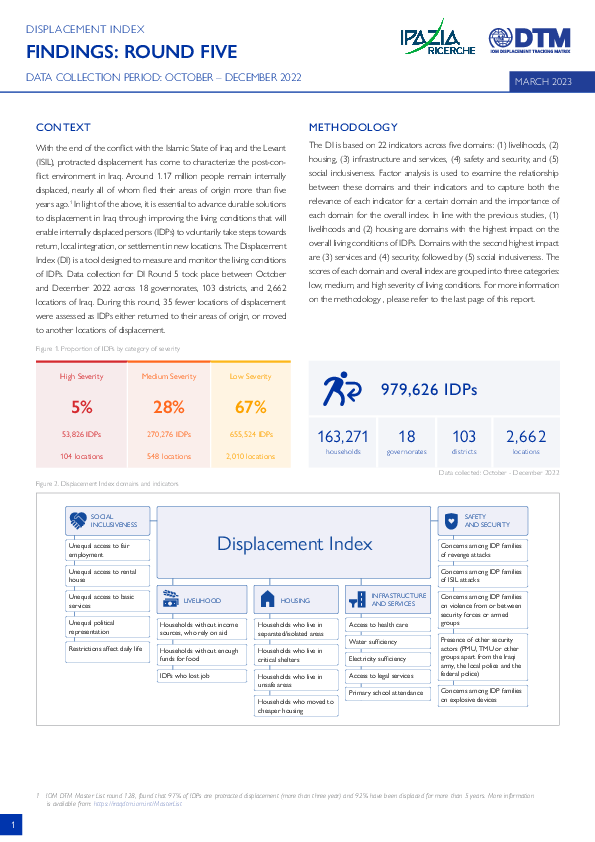
Contact
IraqDTM@iom.int
Language
English
Location
Iraq
Period Covered
Oct 01 2022
Dec 01 2022
Activity
- Survey
- Displacement Solutions
With the end of the conflict with the Islamic State of Iraq and the Levant (ISIL), protracted displacement has come to characterize the post-conflict environment in Iraq. Around 1.17 million people remain internally displaced, nearly all of whom fled their areas of origin more than five years ago.1 In light of the above, it is essential to advance durable solutions to displacement in Iraq through improving the living conditions that will enable internally displaced persons (IDPs) to voluntarily take steps towards return, local integration, or settlement in new locations. The Displacement Index (DI) is a tool designed to measure and monitor the living conditions of IDPs. Data collection for DI Round 5 took place between October and December 2022 across 18 governorates, 103 districts, and 2,662 locations of Iraq. During this round, 35 fewer locations of displacement were assessed as IDPs either returned to their areas of origin, or moved to another locations of displacement.
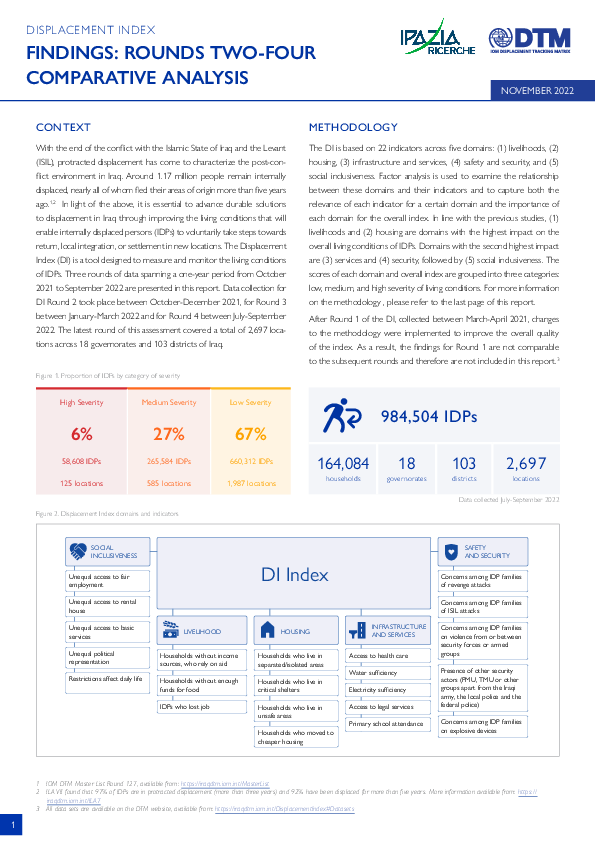
Contact
IraqDTM@iom.int
Language
English
Location
Iraq
Period Covered
Oct 01 2021
Sep 01 2022
Activity
- Survey
- Displacement Solutions
With the end of the conflict with the Islamic State of Iraq and the Levant (ISIL), protracted displacement has come to characterize the post-conflict environment in Iraq. Around 1.17 million people remain internally displaced, nearly all of whom fled their areas of origin more than five years ago.1,2 In light of the above, it is essential to advance durable solutions to displacement in Iraq through improving the living conditions that will enable internally displaced persons (IDPs) to voluntarily take steps towards return, local integration, or settlement in new locations. The Displacement Index (DI) is a tool designed to measure and monitor the living conditions of IDPs. Three rounds of data spanning a one-year period from October 2021 to September 2022 are presented in this report. Data collection for DI Round 2 took place between October-December 2021, for Round 3 between January-March 2022 and for Round 4 between July-September 2022. The latest round of this assessment covered a total of 2,697 locations across 18 governorates and 103 districts of Iraq.
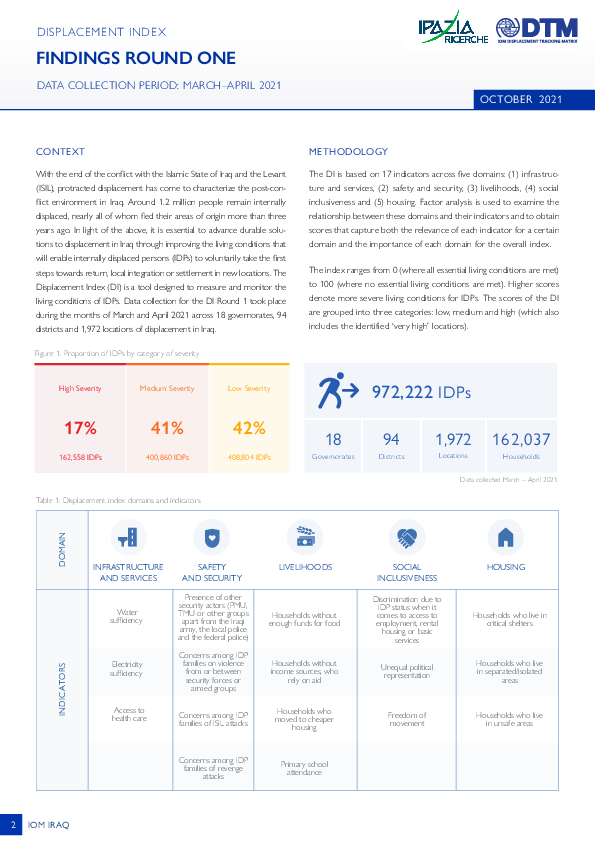
Contact
IraqDTM@iom.int
Language
English
Location
Iraq
Period Covered
Mar 01 2021
Apr 01 2021
Activity
- Survey
- Displacement Solutions
With the end of the conflict with the Islamic State of Iraq and the Levant (ISIL), protracted displacement has come to characterize the post-conflict environment in Iraq. Around 1.2 million people remain internally displaced, nearly all of whom fled their areas of origin more than three years ago. In light of the above, it is essential to advance durable solutions to displacement in Iraq through improving the living conditions that will enable internally displaced persons (IDPs) to voluntarily take the first steps towards return, local integration or settlement in new locations. The Displacement Index (DI) is a tool designed to measure and monitor the living conditions of IDPs. Data collection for the DI Round 1 took place during the months of March and April 2021 across 18 governorates, 94 districts and 1,972 locations of displacement in Iraq.
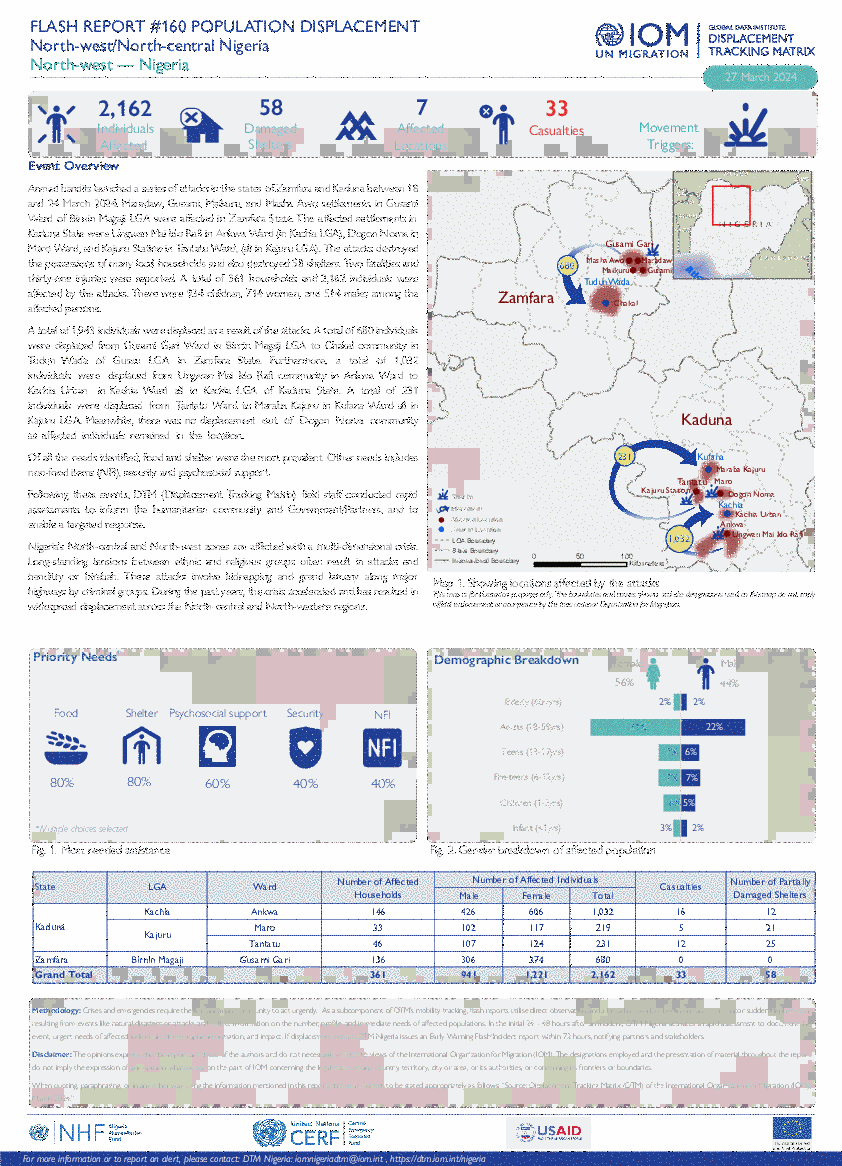
Contact
DTM Nigeria, iomnigeriadtm@iom.int
Language
English
Location
Nigeria
Period Covered
Mar 18 2024
Mar 24 2024
Activity
- Mobility Tracking
- Event Tracking
Armed bandits launched a series of attacks in the states of Zamfara and Kaduna between 18 and 24 March 2024. Maradaw, Gusami, Maikuru, and Masha Awo settlements in Gusami Ward of Birnin Magaji LGA were affected in Zamfara State. The affected settlements in Kaduna State were Ungwan Mai Ido Rafi in Ankwa Ward (in Kachia LGA), Dogon Noma in Maro Ward, and Kajuru Station in Tantatu Ward, (all in Kajuru LGA). The attacks destroyed the possessions of many local households and also destroyed 58 shelters. Two fatalities and thirty-one injuries were reported. A total of 361 households and 2,162 individuals were affected by the attacks. There were 934 children, 714 women, and 514 males among the affected persons.
A total of 1,943 individuals were displaced as a result of the attacks. A total of 680 individuals were displaced from Gusami Gari Ward in Birnin Magaji LGA to Chakal community in Tudun Wada of Gusau LGA in Zamfara State. Furthermore, a total of 1,032 individuals were displaced from Ungwan Mai Ido Rafi community in Ankwa Ward to Kachia Urban in Kachia Ward all in Kachia LGA of Kaduna State. A total of 231 individuals were displaced from Tantatu Ward to Maraba Kajuru in Kufana Ward all in Kajuru LGA. Meanwhile, there was no displacement out of Dogon Noma community as affected individuals remained in the location.
Of all the needs identified, food and shelter were the most prevalent. Other needs include non-food items (NFI), security and psychosocial support.

Contact
DTM Nigeria, iomnigeriadtm@iom.int
Language
English
Location
Nigeria
Period Covered
Mar 11 2024
Mar 17 2024
Activity
- Mobility Tracking
- Event Tracking
On 15 March 2024, armed bandits attacked the communities of Balisa, Jimrawa, Kaura Zomo and Sodingo in Dan Isa ward of Kaura Namoda LGA in Zamfara State. The attacks caused one fatality but no injuries were reported. The attacks affected 2,240 individuals in 373 households. The affected individuals included 1,257 children, 541 women and 442 men.
Of all the needs identified, food and security were the most prevalent. Other needs included shelter and non-food items (NFI).